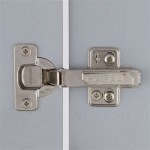How To Clean Inside New Kitchen Cabinets With Vinegar
The installation of new kitchen cabinets often marks a significant investment and an exciting upgrade to a home. However, even brand-new cabinets can harbor dust, debris, and residual manufacturing odors. Cleaning them thoroughly before stocking them with cookware and food items is crucial for ensuring a hygienic storage environment and preserving the cabinets' pristine condition. Vinegar, a readily available and natural cleaning agent, provides an effective and safe solution for this purpose. This article details a comprehensive method for cleaning the inside of new kitchen cabinets using vinegar, ensuring optimal hygiene and long-term maintenance.
Before embarking on the cleaning process, it's essential to gather the necessary materials. A clean, empty spray bottle is required for dispensing the vinegar solution. Soft cloths, preferably microfiber, are necessary for wiping down the cabinet surfaces without scratching or damaging the finish. A small bowl or bucket will be needed for mixing the vinegar solution if preferred over direct spraying. Warm water is also required for diluting the vinegar and rinsing the cabinets. Protective gloves are recommended to prevent skin irritation, particularly for individuals with sensitive skin. A dust mask may be helpful to avoid inhaling any dust or particles released during the cleaning process. Finally, a vacuum cleaner with a brush attachment can be used to initially remove loose debris before applying the vinegar solution.
Preparation is Key: Emptying and Initial Cleaning
The first step involves preparing the cabinets for cleaning. This entails removing any packaging materials, such as cardboard, plastic wrap, or protective films, that may be present inside the cabinets. Discard these materials responsibly. Next, use the vacuum cleaner with a brush attachment to thoroughly remove loose dust, sawdust, and any other debris that may have accumulated during manufacturing, shipping, or installation. Pay particular attention to corners, edges, and crevices, as these areas tend to collect more debris. The initial vacuuming stage is vital for preventing the vinegar solution from simply spreading the dust around and creating a muddy residue.
Following the vacuuming, perform a dry wipe-down of the cabinet interiors with a clean, dry cloth. This step ensures that any remaining loose particles are removed before applying the vinegar solution. Consider using a tack cloth, which is specifically designed to pick up dust and lint effectively. The preparatory cleaning steps are crucial for maximizing the effectiveness of the vinegar solution and achieving a truly clean surface.
Vinegar Solution: Mixing and Application
White vinegar is a versatile and effective cleaning agent due to its acidic properties, which help to dissolve grease, grime, and odors. For cleaning new kitchen cabinets, a diluted vinegar solution is generally recommended to prevent damage to the cabinet finish. A common ratio is a 1:1 mixture of white vinegar and warm water. This solution is gentle enough for most cabinet surfaces yet strong enough to effectively clean and deodorize.
To prepare the vinegar solution, combine equal parts of white vinegar and warm water in the spray bottle or bowl. Shake or stir the mixture thoroughly to ensure it's well combined. If using a spray bottle, adjust the nozzle to a fine mist setting to avoid oversaturating the cabinet surfaces. When applying the vinegar solution, spray a light, even coat onto the interior surfaces of the cabinets. Avoid spraying large quantities directly onto the wood or laminate, as excessive moisture can potentially damage the material over time. If using a bowl, dampen a clean microfiber cloth with the vinegar solution, ensuring it's not dripping wet, and then wipe down the interior surfaces of the cabinets.
When cleaning, work in sections to ensure thorough coverage. Pay close attention to areas that may have accumulated more dust or grime, such as corners, shelves, and the bottom surfaces of the cabinets. For stubborn spots or stains, allow the vinegar solution to sit for a few minutes before wiping it away. The brief soaking time allows the vinegar to penetrate and loosen the grime, making it easier to remove. Remember to test the vinegar solution on an inconspicuous area of the cabinet before cleaning the entire surface to ensure that it doesn't damage the finish.
For cabinets with adjustable shelves, remove the shelves before cleaning to ensure access to all the interior surfaces. Clean the shelves separately using the same vinegar solution and wiping technique. Allow the shelves to dry completely before reinstalling them in the cabinets. This approach ensures that all surfaces are thoroughly cleaned and prevents moisture from being trapped inside the cabinets.
Drying and Ventilation: Ensuring a Fresh Finish
After wiping down the cabinets with the vinegar solution, it’s crucial to allow them to dry thoroughly. Wipe the surfaces with a clean, dry microfiber cloth to remove any excess moisture and prevent water spots. Open the cabinet doors and windows to promote ventilation and facilitate the drying process. A circulating fan can also be used to speed up drying time.
Allow the cabinets to air dry completely before storing any kitchenware or food items inside. This is essential for preventing the growth of mold and mildew, which can thrive in damp environments. The drying time may vary depending on the humidity level and ventilation in the room. Generally, allowing the cabinets to air dry for several hours or overnight is recommended to ensure complete dryness.
Once the cabinets are completely dry, inspect them for any remaining residue or streaks. If necessary, repeat the cleaning process with a fresh vinegar solution or simply wipe the surfaces with a clean, damp cloth. Ensure the cabinets are thoroughly dried again after any additional cleaning. The goal is to achieve a clean, hygienic, and odor-free storage space for kitchen essentials.
In conclusion, utilizing vinegar to clean new kitchen cabinets is a safe, effective, and eco-friendly method. By following these detailed steps of preparation, solution application, and proper drying techniques, individuals can ensure their new cabinets are clean, fresh, and ready for use. This process not only improves hygiene but also contributes to the long-term preservation of the cabinet's finish and overall aesthetic appeal.

How To Clean White Kitchen Cabinets 3 Best Ways Avoid Abbotts At Home

How To Clean Wood Kitchen Cabinets Like A Boss Shelfgenie

3 Ways To Clean Wood Kitchen Cabinets Wikihow Life

How To Clean Kitchen Cabinets 9 Basics Bob Vila

We Tried 5 Methods To Clean Greasy Wood Cabinets And The Winner Is Ridiculously Effective Kitchn Cleaning

How To Deep Clean Kitchen Cabinets And Keep Them Looking Gorgeous Everyday Skate

How To Clean White Kitchen Cabinets 3 Best Ways Avoid Abbotts At Home

5 Expert Ways To Clean Wooden Kitchen Cabinets Everyday Old House

Ultimate Guide To Cleaning Kitchen Cabinets Cupboards Foodal

Tips To Clean Kitchen Cabinets Healthylife Wer
Related Posts








